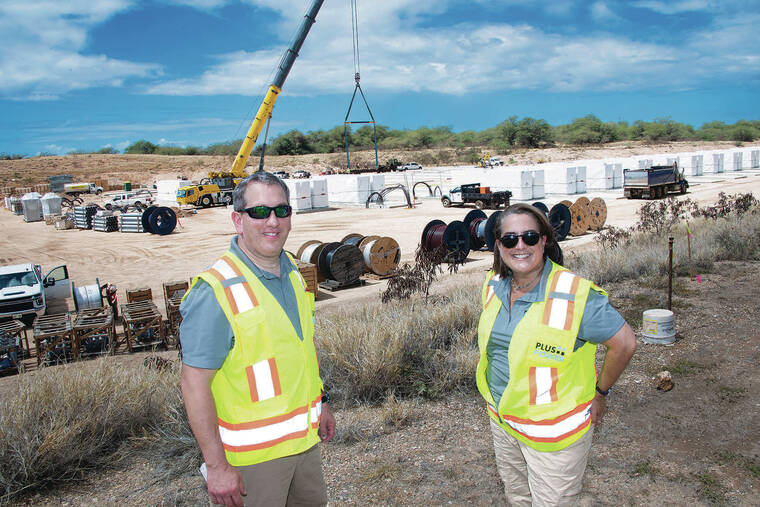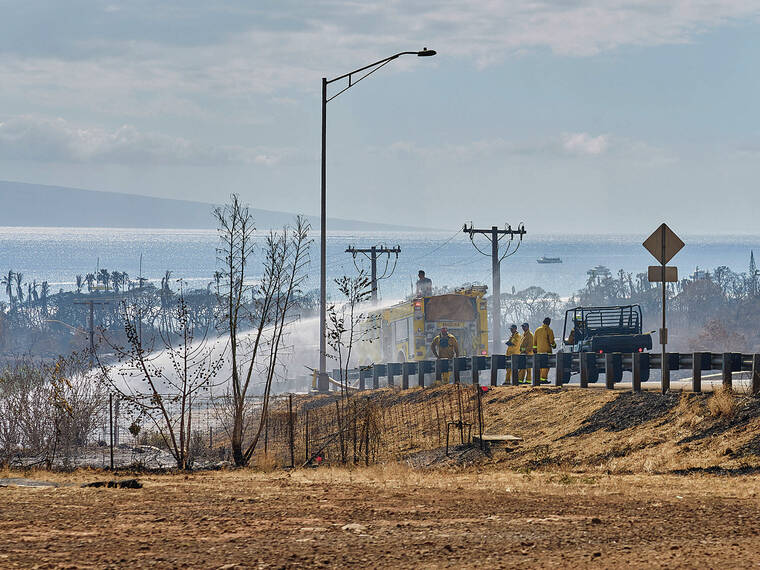Energy storage for Oahu taking shape in Kapolei

CRAIG T. KOJIMA / CKOJIMA@STARADVERTISER.COM
Chris Quaranta, left, Plus Power director of engineering and construction, and Polly Shaw, the company’s head of policy and communications, gave a construction site tour Monday of a battery storage system being built in Kapolei to store electricity generated by solar farms elsewhere on the island.

COURTESY KAPOLEI ENERGY STORAGE
An aerial view of Plus Power’s 185-megawatt/ 565-megawatt-hour Kapolei Energy Storage Project on Oahu.


A giant battery pack designed to give Oahu’s electrical grid added flexibility and stability is projected for completion in May after nearly a year of delay.
The developer of the system capable of storing 565 megawatt-hours of energy provided an update on construction Monday.
Almost half of 158 Tesla Megapack lithium-ion batteries have been delivered, and about one-third have been installed at the project’s 8-acre site near Kalaeloa Harbor.
The project by San Francisco-based Plus Power will be the largest stand-alone energy storage system in the state and will allow utility company Hawaiian Electric to accept more intermittent power generation from renewable sources, including rooftop solar, that replace fossil fuel power plants over the long term.
“It will help create grid stability,” Polly Shaw, head of policy and communications for Plus Power, said about the project, called Kapolei Energy Storage. “We’re very very excited about it.”
Kapolei Energy Storage was one of several renewable energy projects selected by Hawaiian Electric two years ago through a competitive bidding process subject to approval by the state Public Utilities Commission.
Don't miss out on what's happening!
Stay in touch with breaking news, as it happens, conveniently in your email inbox. It's FREE!
Plus Power held a groundbreaking ceremony in August 2021, though construction didn’t begin until April.
Initially, the battery system was projected to become operational this past June, but more recently got pushed back to the end of this year and then to May.
The delays stem mainly from battery component factory shutdowns in China prompted by coronavirus lockdowns, as well as a reduction in shipping capacity for lithium-ion batteries on cargo ships coming to Hawaii, according to reports filed with the PUC.
There has been concern expressed by some state lawmakers and the PUC that delays in developing the energy storage facility and some planned solar energy farms on Oahu could leave Hawaiian Electric with an insufficient cushion of power following the recent shutdown of a coal-fired power plant.
This 185-megawatt plant owned and operated by AES Corp. closed Sept. 1 after 30 years of operation. Hawaiian Electric has stated that it has enough capacity to provide reliable service, and noted Monday that the Kapolei Energy Storage system is not offsetting any loss of power production by the former coal plant.
Shaw said the battery system will allow Hawaiian Electric to increase its acceptance of renewable energy on Oahu by 10% and also will allow the utility company to avoid curtailing renewable energy production from wind or solar farms when the wind and sun are producing more power during the day than what is being consumed.
The utility company expects that 40% of the energy going into the batteries will be from renewable sources initially and grow to 63% by 2040 as more renewable power plants replace oil-fueled plants.
Currently, about 33% of all power produced on Oahu by or for Hawaiian Electric is from renewable sources. The state has mandated that this share reach 100% by 2045 statewide.
Hawaiian Electric plans to use about 73% of Kapolei Energy Storage’s capacity for daily use. This amount is roughly what would be used by around 32,000 homes, and represents about 10% of peak use.
The balance is to be reserved for accepting or discharging power whenever Hawaiian Electric has such a need, which could include offsetting the loss of generation due to unforeseen circumstances.
“It’s a shock absorber for the grid,” said Chris Quaranta, director of engineering and construction for Plus Power.
Hawaiian Electric will pay Plus Power around $500 million for the service over 20 years, and has estimated that the resulting flexibility and stability should save a typical residential customer, which consumes 500 kilowatt-hours of electricity a month, about 28 cents on a monthly bill over the contract term with Plus Power.




